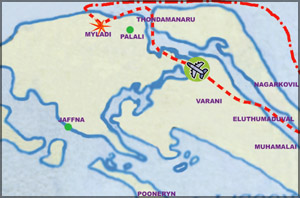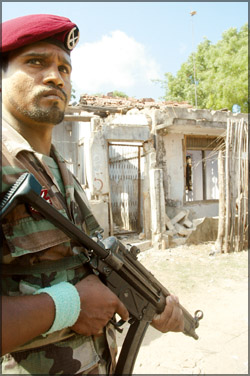 Govt, Security Forces rising to challenge of establishing extensive
Air Defence System Govt, Security Forces rising to challenge of establishing extensive
Air Defence System
LTTE fails to attack Palaly by air due to troopsâ swift action; Tiger
Air Wing a desperate attempt to boost faltering image:
AIR DEFENCE: The LTTE made their second attempt to launch an air
attack on Tuesday, despite their failure to achieve their objective at Katunayake Airbase on April 2.
This time too they miserably failed in their endeavour as the
Security Forces were on full alert about an impending air attack by the
LTTE. The fierce resistance by the troops at Achchuveli and Palaly air
base compelled them to give up their target and drop the bombs in an
unexpected location at Myladi.
The Tiger Air Wing this time too made use of the same tactics as they
did during the air attack on Katunayake airbase. They used the same time
period they used to launch the attack on Katunayake air base, this time
too to take advantage of the darkness and to escape becoming a direct
target of the Security Forces fire.
But this time they had the target within the range of their artillery
guns, to divert the attention of the Security Forces.
The Tigers at Pooneryn drew their artillery guns, after a lapse of a
few months, to take the Palaly High Security
|

The flight path of the LTTE aircraft.
|
Zone within their artillery range.
They commenced firing artillery rounds at 1.05 am towards the Palaly
High Security Zone. Security Forces Headquarters in Palaly reacted to
this situation within minutes, with artillery and Multi Barrel Rocket
launchers.
Ten artillery rounds of the LTTE fell within the HSZ limits while
another 10 fell outside the HSZ according to Security Forces.
While the Forces were taking measures to neutralise the artillery
fire of the LTTE from Pooneryn side troops manning FDLs south of the
Jaffna peninsula informed the Palaly Air Base about the sound of a
suspicious aircraft heading towards Palaly at 1.10 a.m. five minutes
after the LTTE started firing artillery rounds.
But there was a small delay on the part of the Security Forces to
identify whether it was their own aircraft or an enemy aircraft as an
Air Force plane was on a maritime patrol and reconnaissance mission in
the area.
But troops at Achchuveli identified it as an enemy aircraft and fired
towards it as it tried to enter the Palaly HSZ from Achchuveli. Due to
the firing of troops they had diverted their air path towards
Thondamanaru and tried to enter Palaly Air Base.
But, by this time all the guns at the Palaly airbase were ready to
face the Tiger aircraft as they heard the sound of the aircraft flying
at tree top level without lights, and guns started firing at the
aircraft.
Having failed to enter the Palaly Air Base due to heavy resistance by
the troops, the Tiger aircraft again diverted its path as they realised
they cannot do any harm to the Palaly air base. They dropped three bombs
at Myladi just 50 metres away from the sea as they found no other place
to drop the bombs before reaching their escape route from the sea belt.
|

MINIMAL IMPACT: Jaffna Security Forces Commander Major General G.A.
Chandrasiri points to a hole in the ground created by one of the
crude LTTE bombs.
|
Six soldiers fell victim to the crude bombs made of iron balls that
fell at Myladi junction on the Palaly-KKS road at 1.20 a.m. The Tiger
craft then had proceeded to the Wanni within minutes from the
Thondamanaru side. (The path taken by the Tiger air craft is marked in
the map)
Though the Tiger outfit made a big noise about their mission, using
its media network, they had not achieved much other than two small holes
that had been created due to the explosion of the bombs in Myladi close
to some old buildings.
To do a small damage, they first flew all the way from Wanni to
Katunayake on the previous occasion. It was obvious that the Tigers took
such a risk, since they launched the attack on the Katunayake air base.
They than had the advantage of a surprise attack.
But this time they selected a short distance target, to take a
minimal risk on the Tiger Air Wing as the âsurprise factorâ no longer
existed.
Adding to this they minimised the risk component, taking a different
path to return to the Wanni after its failed mission in Palaly as they
were well aware that there wonât be any return journey if they took the
same path.
However, the question is, why the LTTE had used one of their precious
assets to cause such a small damage. According to Security Forces
assessment, the LTTE has the capability to cause bigger damage, using
their artillery guns located more than 20 Kilometres away from Palaly
air base.
Therefore, it is obvious that the LTTE has engaged in a psychological
operation through this air attack as they had already tasted it, through
the publicity campaign they launched following the air attack on the
Katunayake Air Base.
The LTTE, which is now in its weakest position in the 30 years long
history of the internal conflict of Sri Lanka, is in need of an
immediate image boost locally and internationally.
One objective they are trying achieve through this image boost is to
convince the Tamil diaspora across the globe vis-a-vis their fund
raising campaigns.
This is because, many countries have frozen the channels of funds to
the LTTE through the proscription of the LTTE as a terror organisation.
The Tamil diasporaâs unwillingness to contribute to a weakening
organisation which is facing continuous defeats at the hands of the
Security Forces.
Therefore, it was an immediate necessity, on the part of the LTTE to
have an international image boost to achieve their objective
internationally.
The other objective of the LTTE is to boost its recruitment drive,
after convincing young Tamils of their capabilities. The Tiger outfit is
now facing a severe shortage of manpower, with hundreds of their cadres
killed during Eastern battles while hundreds of other cadres are
deserting the organisation unable to bear the tragic circumstances they
had to face in battles.
The Tiger leader may made use of this attacks to convince the cadres
as to why they should not desert the organisation. But, it is
unrealistic on the part of the LTTE to mislead the Tamil community,
using this game as
|

A deserted building damaged due to LTTE bombs.
|
a tool, as the Tamil community is wise enough to differentiate
reality from fantasy.
The second question is why the Security Forces were unable to destroy
the enemy aircraft for the second time with more troops attempting to
shoot at the aircraft using various type of guns.
Though, it appears to be a simple task for those who are critical of
the situation, it is a difficult task for the troops on duty to detect
an air craft, flying at tree top level, since it is visible to them only
for a few seconds.
The task becomes extremely difficult at night since they have to
detect the aircraft only with its sound, since the Tiger aircraft had
flown without lights on both occasions.
The soldiers in Myladi after they got the message about the enemy
aircraft, tried their best to fire at the enemy aircraft, when it came
to an open space close to the coast. This correspondent met many of the
soldiers who fired at the LTTE aircraft, detecting it only by its sound,
when he visited Palaly on Wednesday.
They explained how difficult it is to detect an aircraft which is
flying at tree top level. They had heard only the sound but not seen the
aircraft.
But the Tiger cadres on the aircraft probably equipped with night
vision equipment must have seen the real danger when soldiers came out
of their bunkers to fire at them after reaching open air space in the
coast.
That must have been the exact reason for dropping bombs at Mylady
junction which is only 50 metres away from the coast.
The third question that has arisen from this attack is as to why the
Air Defence System (ADS) could not detect this Tiger Aircraft for the
second time. During the first incident, there had been a technical fault
with the Air Defence System.
According to the explanation given by the military, an active Air
Defence System would basically function on four broad principles.
It begins with the function of detection where respective mechanisms
are in place to render early warning of an enemy aircraft and it can be
done either through Electronics (radar), Visual Observation or
Intelligence. Currently the most favoured means across the globe is the
Radar.
After the detection the second basic principle involved in the ADS is
to have an identification mechanism to identify whether the detected
suspicious target is friend or foe (IFF - Identification Friend or Foe).
Immediately after identification, an evaluation of the imminent
threat needs to be done with lightning speed to ascertain the size, the
probable payload and the speed of the target to facilitate the
instantaneous assignment of weapons for example either interceptors,
Missiles or AD guns.
The forth step in the ADS is weapons assignment. During this decisive
phase, the weapon that can inflict the severest destruction to the
target will be opted for. Enemy aircraft too close to a vulnerable area
would immediately be subjected to âMissile Fireâ, depending on their
deployment, failing which Point Defence Mechanism, the Anti Aircraft
Artillery would be activated.
For the establishment of an effective ADS, Controlling and Reporting
Organization (Air Defence Radar System), Radar Guided Defence Gun
System/ Anti Aircraft Artillery Guns and Surface to Air Guided Missile
System are essential components.
When M.K. Narayanan, National Security Advisor to Government of India
writing to then Sri Lankan President Chandrika Bandaranaike Kumaratunga
in September 2005, mentioned in his letter, âthe Air Defence
capabilities cannot be developed overnight since both concepts and
infrastructure are involvedâ, in the process of establishing ADS.
That explained how difficult it is to establish an Air Defence
System.
But, according to military experts the Air Defence Systems available
at present are meant for conventional type of warfare. They are
basically to detect aircraft from enemy countries, but not within their
territory.
The conventional type of ADS cannot detect aircraft flying at tree
top level.
Therefore, the task of the Air Force has now become more complex. The
first option, available with them is to destroy the Tiger Air Wing on
the ground. Since, the Tiger Air Wing, according to intelligence
reports, is equipped only with less than three aircraft, they could be
destroyed on the ground.
That needs surveillance and intelligence gathering to locate the
aircraft.
The second option available for them is to have 24 hour surveillance
to detect the Tiger aircraft as soon as they take off from the Tiger
hideout in Wanni and activate the ground attack systems to destroy the
aircraft.
Therefore, for such 24 hour surveillance a 3-D radar system is a must
since it enables them to intercept the exact location, from which the
aircraft had taken off, the speed of the aircraft and the altitude.
It is incumbent upon the SLAF to take whatever possible steps to nip
the Tiger Air capabilities in the bud, not allowing the LTTE to develop
further, without repeating the mistake that had happened when LTTE
formed it Sea Tiger wing.
If authorities had taken steps to destroy the Sea Tiger capabilities,
once the Tigers exposed their sea capabilities, the problem would have
become this worse today.
In the same way, those who are critical of this Government are
unaware of the fact that it was only the present Government which had
laid a solid foundation to face Tiger air capabilities, by initiating
the process of establishing Air Defence System in the year 2005.
In this context, a word of appreciation should also go to then Air
Force Commander now holding the position of Chief of Defence Staff Air
Chief Marshal Donald Perera for his courageous remarks when he wrote a
letter to then President Chandrika Bandaranaike Kumaratunga about the
Air Defence System of the country.
As a final remark on this column it is apt to quote the courageous
remarks made by then Air Force Commander in his letter: âWhilst
appreciating the assistance offered by a Government of a friendly nation
to establish an Air Defence System for Sri Lanka it is strongly warned
that National Air Defence Plan for Sri Lanka should not be compromised
due to any external influence or pressures.â |

